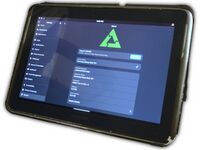Samsung Galaxy Note 10.1 (samsung-p4note)
 Samsung Galaxy Note 10.1 running postmarketOS with Phosh | |
| Manufacturer | Samsung |
|---|---|
| Name |
Galaxy Note 10.1 WiFi 3G |
| Codename | samsung-p4note |
| Model | GT-N8000/05/10/13/20 |
| Released | 2012 |
| Type | tablet |
| Hardware | |
| Chipset | Samsung Exynos 4412 Quad |
| CPU | Quad-core 1.4 GHz Cortex-A9 |
| GPU | Mali-400 MP4 |
| Display | 1280x800 PLS TFT |
| Storage | 16/32/64 GB |
| Memory | 2 GB LPDDR2 |
| Architecture | armv7 |
| Software | |
Original software The software and version the device was shipped with. |
Android 4.0.3 |
Extended version The most recent supported version from the manufacturer. |
Android 4.4.2 |
| postmarketOS | |
| Category | testing |
Mainline Instead of a Linux kernel fork, it is possible to run (Close to) Mainline. |
yes |
| Device package |
|
| Kernel package |
|
Flashing Whether it is possible to flash the device with pmbootstrap flasher. |
Works
|
|---|---|
USB Networking After connecting the device with USB to your PC, you can connect to it via telnet (initramfs) or SSH (booted system). |
Partial
|
Battery Whether charging and battery level reporting work. |
Partial
|
Screen Whether the display works; ideally with sleep mode and brightness control. |
Works
|
Touchscreen |
Works
|
| Multimedia | |
3D Acceleration |
Works
|
Audio Audio playback, microphone, headset and buttons. |
Partial
|
Camera |
Broken
|
| Connectivity | |
WiFi |
Works
|
Bluetooth |
Works
|
GPS |
Untested
|
| Modem | |
Calls |
Broken
|
SMS |
Broken
|
Mobile data |
Broken
|
| Miscellaneous | |
FDE Full disk encryption and unlocking with unl0kr. |
Broken
|
USB OTG USB On-The-Go or USB-C Role switching. |
Broken
|
| Sensors | |
Accelerometer Handles automatic screen rotation in many interfaces. |
Untested
|
Contributors
- Daniel Sosa
Users owning this device
- AmateurPenguin (Notes: Dumb Ways to 'brick your tablet')
- Bastindo (Notes: Running LineageOS, daily driver streaming tablet)
- Devbrones (Notes: dead battery)
- FerassElHafidi (Notes: Doesn't show anything on the LCD :( Probably broken LCD connector. I remember the colours being very funky before. Seems like a common fault...)
- Hjin06park (Notes: currently using this as dual boot machine)
- Jacobk (Notes: I lost the charging cable)
- Kocourek (Notes: N8010, pmOS with sxmo)
- Maledict (Notes: Running pmOS)
- Newbyte (Notes: Running pmOS)
- Overcast302
- TeraByte38 (Notes: Fully working, pmOS Phosh, GT-N8010)
- TheSame (Notes: Running LOS16 and pmOS)
- TryzenAlpensky (Notes: Android 9)
- VertexIsHere (Notes: 2x3G models, one is dead, the other one is running on stock, dead battery)
- Viciouss (Notes: 2xN8000, N8010, N8020)
- Vrebagliati
Variants
There are a lot of variants of the p4note with the N80x0 being the most common ones as they were distributed internationally. There are also some branded versions in the US (device name SCH-/SPH-) and South Korea (SHW-/SHV-).
Aside from the modems, they seem to have the same hardware. Wifi, touch screen and audio configurations are different and some of the wiring doesn't quite match.
| Model Number | Codename | Feature |
|---|---|---|
| N8000 | p4noterf | 3G |
| N8005 | - | 3G (no calls) |
| N8010/N8013 | p4notewifi(ww) | Wifi only |
| N8020 | p4notelte | LTE |
Issues
Audio
The Exynos 4412 Quad has audio support, but it is hit-or-miss and here it is very dodgy, with xfce4 making sound only using the headphone jack and KDE and Phosh not making a sound.
Charging
Charging works, but is slow. You'll probably need to turn the display off for the charge to increase.
On GNOME, the charging state icon doesn't change until you restart the device.
WiFi
If your device is N8020, you'll likely need to run this command to be able to connect to WiFi networks. Otherwise, WiFi is functional.
$ sudo ln -sf /lib/firmware/brcm/brcmfmac4334-sdio.samsung,i9305.txt /lib/firmware/brcm/brcmfmac4334-sdio.samsung,n8010.txt
Non-functional hardware
The S-Pen is currently not working.
Tested Desktop Environments
Tested with pmbootstrap install --disk=/dev/xxx (sd card method). "Working" boots to the desktop, "Not working" does not.
Working
Not working
Maintainer(s)
- k2luawaken
How to enter flash mode
Press and on power up.
Volume down is the side of the volume rocker that is closest to the power button.
Installation
Use pmbootstrap install --sdcard=/dev/XXX (which is your SD card) to install onto an SD card, use pmbootstrap export to grab the boot.img (should fit, if not then something is wrong) and flash using TWRP.
Mainline Kernel
- Mainline kernel support matrix: https://viciouss.github.io/static_pages/galaxy_note_10_1_mainline/
- Blog post about Mainlining efforts: https://viciouss.github.io/2020/11/18/note-10_1-journey/
- XDA forum post about the mainline kernel work being done on this device: https://forum.xda-developers.com/galaxy-note-10-1/general/mainline-n8000-progress-t3964980
- Git Repositories for the work being done by Viciouss to mainline this device and get Android running on it: https://github.com/Viciouss?tab=repositories
- Mainline DTS: https://git.kernel.org/pub/scm/linux/kernel/git/next/linux-next.git/log/arch/arm/boot/dts/exynos4412-p4note-n8010.dts
- The accepted commit which added mainline support for this device in PostmarketOS is here
- The pmaports git repo for this device is in "testing" here.
See also
- pmaports!233 Initial merge request (Closed, not merged)
- Replicant wants to support this device as well
- pmaports!2908 Current merge request